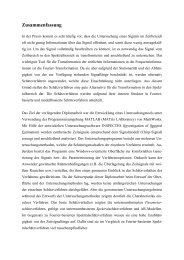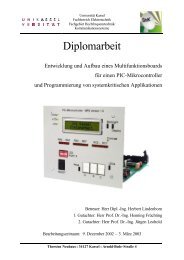DSP Signal Generator Implementation On C6713 DSK - ComLab
DSP Signal Generator Implementation On C6713 DSK - ComLab
DSP Signal Generator Implementation On C6713 DSK - ComLab
You also want an ePaper? Increase the reach of your titles
YUMPU automatically turns print PDFs into web optimized ePapers that Google loves.
3 <strong>Implementation</strong><br />
In this section implementation of signal generator on <strong>C6713</strong> <strong>DSK</strong> is discussed. For the ease of<br />
reader different functionalities of signal generator are discussed as independent modules where<br />
later all these modules are incorporated in a single program. To access the source code of this<br />
program, please refer to the file “sine_varFreq.c” which is present in the folder “sine_varFreq”,<br />
included in the attached CD-ROM. It is assumed that the reader has a basic knowledge of C/C++<br />
and has read [4].<br />
3.1 Waveform Generation<br />
The <strong>C6713</strong> <strong>DSK</strong> can be used to generate various types of waveforms which have wide range of<br />
applications in communication systems. In this section generation of periodic waveforms namely<br />
sine wave, square wave, triangular wave, sawtooth wave and multi tone signal generation is<br />
discussed.<br />
3.1.1 Sine Wave Generation<br />
<strong>On</strong>e of the main things to take in account in generating any waveform is writing the sample<br />
values of waveform on the codec at every sampling instant. In the DAC done at the codec these<br />
sample values of the waveform are first oversampled (to smoothen the waveform) and are then<br />
fed to a reconstruction filter (to cut frequencies out of band of interest).<br />
There are two techniques for sending the data to codec namely polling technique and interrupt<br />
technique. Polling technique uses a continuous procedure of testing when the data is ready.<br />
Although it is simpler technique than interrupt technique, it is less efficient since the input and<br />
output data needs to be continuously tested to determine when they are ready to be received or<br />
transmitted. Figure 3.1 shows sine wave generated using interrupts technique, source code is<br />
shown in figure 3.2.<br />
12





